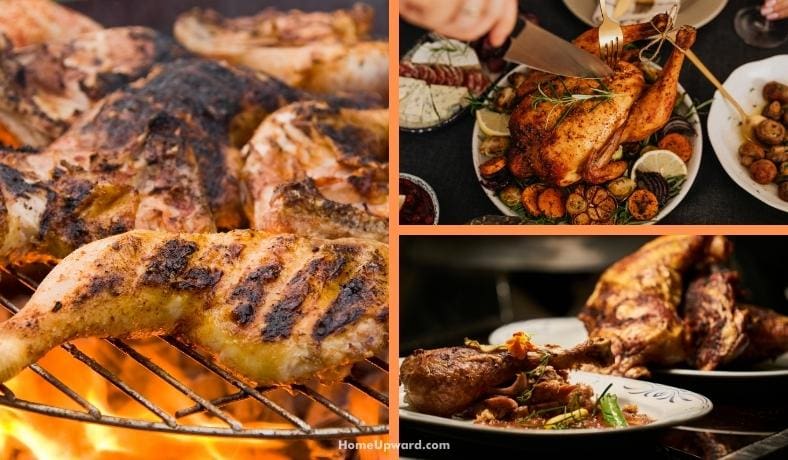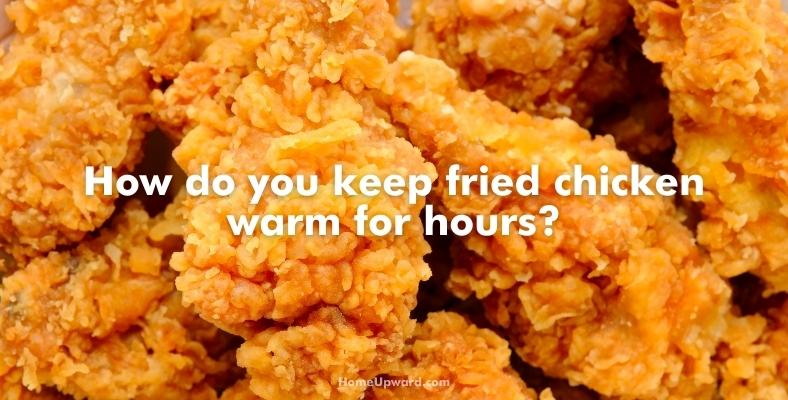Contents
- How Long Can You Keep a Cooked Chicken Warm Safely?
- Keeping cooked chicken warm without drying it out
- How do you keep grilled chicken warm after cooking?
- How to keep a rotisserie chicken warm
- How do you keep fried chicken warm for hours?
- Keeping warm chicken in a slow cooker or crockpot
- Keeping chicken wings warm and crispy
- How to keep food warm when transporting it
- How to reheat chicken safely and for the best results
How Long Can You Keep a Cooked Chicken Warm Safely?
While we might usually assume it’s only raw chicken that is liable to spoilage, there’s a countdown that starts once someone removes chicken from the frying pan, oven, air fryer, or grill. To be safe you should only keep warm chicken out of the oven or fridge for two hours.
That said, what you want to do is avoid the “Danger Zone” – the temperature range between 40 and 140 degrees Fahrenheit where bacteria can grow extremely quickly.
That means that if you keep your chicken in an oven that’s set at 140 Fahrenheit or higher (keeping it warm and fresh, also) you’ll be safely keeping it until you can eat it later.
How long can cooked chicken sit out covered?
Even if a chef covers cooked chicken under foil or another covering, it’ll likely never reach an internal temperature of 140 degrees. Regardless of what you cover it with, if it’s not being supplied heat like in an oven or warm, it’ll cool over time.
That means you should only leave cooked meat out covered for two hours or for only one hour if the temperature around you is above 90°.
Is it OK to leave fried chicken out overnight?
No, it’s very unsafe to leave fried chicken out overnight. Chicken left out for more than two hours can become a breeding ground for bacteria that cause food poisoning, like salmonella, E. coli and Staphylococcus aureus.
These are some of the most common bacteria and responsible for people getting sick due to improperly handled foods especially meat.
Keeping cooked chicken warm without drying it out
Almost as bad as a dangerously undercooked chicken is an excessively dry one. Unfortunately, it’s all too easy to dry out the chicken when we’re just trying to keep it warm and tasty.
Thankfully, there are a few tricks to keeping cooked chicken warm without drying it out:
- Most ovens and toaster ovens have a setting or temperature range for keeping food warm. Many go as low as 140 or 150°F and have a setting just for that.
- As an example, I set my toaster oven or large oven to a temperature between 150 and 200. That’s a good temperature range for keeping it warm without drying it out.
- If the chicken is especially sensitive to drying, sometimes you can splash some water on the bottom of a cooking tray then place the chicken on top and cover it with aluminum foil. As the water heats, it will begin to convert into steam, keeping the chicken moist without overheating it. Once it’s had time to warm & freshen up you can remove it with oven mitts.
- When it comes to the range between 150 and 200 degrees, a low temperature is better. The key is to keep chicken hot enough that bacteria can’t easily grow and multiply. At the same time, you don’t want to keep it so warm that it’ll dry out the bird’s insides.
How do you keep grilled chicken warm after cooking?
Grilling chicken breasts, thighs, and wings can be an incredible treat for a warm spring or summer night, but what’s the secret to keeping these amazing cooked chicken treats warm?
Depending on the layout of the grill and kitchen space, most people have a few options. For example, if I have room to move back and forth between the kitchen and grill I can follow the same procedure above and put my chicken in a warmed oven.
That’ll keep it warm without reducing its smoky flavor.
If you can’t get to the kitchen from the grill easily, it’s fine! It’s easy to tightly wrap a grilled chicken in aluminum foil to keep in the heat and the moisture in so the flavor and texture won’t be ruined. It’ll also keep the heat in for long enough (within reason) for you to keep it warm at a safe temperature.
How to keep a rotisserie chicken warm
Reheating rotisserie chicken or keeping it warm is simple. I like it because it requires an oven as opposed to a grill or deep fryer, meaning I don’t have to do anything besides changing the oven temperature.
It’s one of the easiest ways to keep your delicious chicken warm and not get anybody sick!
When it comes to keeping the cooked chicken warm after cooking it rotisserie style, put your rotisserie chicken in the oven set to a temperature of 170–200 degrees Fahrenheit.
Worried about the chicken drying out? Cook it in a cooking dish with a bit of water (or spray it with clean, fresh water lightly) then wrap it in foil tightly. Try to keep it relatively leak-proof so nearly all the moisture and heat are kept inside for the best results freshness-wise.
Don’t worry though – it doesn’t have to be perfectly airtight when covered in foil.
How to reheat a rotisserie chicken in the oven
Reheating cooked rotisserie chicken is just as simple! If your chicken has been out for a little while, then put it in the oven at 170–200 degrees for about twenty minutes to warm it back up.
When you’re reheating roasted chicken from the refrigerator, you’ll want to change the process a little bit: turn the heat up to 350 or 400 degrees and keep the chicken in for 15–30 minutes until it’s hot inside.
What temperature should I keep a rotisserie chicken warm?
Keeping a rotisserie chicken warm after its finished cooking couldn’t be easier. Once you’re sure the chicken meat is cooked well (a cooking thermometer is great for this, checking to see if the meat is 176° or more inside), put it back in the oven and lower the temperature to 170–200 degrees.
Leave it there until it’s time to eat.
How do you keep fried chicken warm for hours?
As any Southern food fanatic can confirm, it’s a bit tricky to reheat fried chicken and keep it warm. It’s crucial not to dry it out but it’s also bad to get it so damp that it reduces the crispiness of the fried outside and batter.
It’s absolutely wrong to keep fried chicken out on the counter for hours. Leaving cooked chicken out for any more than two hours makes it a target for bacteria and puts you at risk for foodborne illnesses.
If you’d like to keep your fried chicken crispy and warm for a long time, go for a heating option like a heat lamp, air fryer with warming mode, a toaster oven, or another source of heat that keeps bacteria away but doesn’t dry out the chicken. In most cases, that’s an appliance with a sealed or shut door or container for the food.
I’ve tried to put the chicken in containers and keep them warm buffet style, but the better option is to put each chicken piece on drip pans and keep it in the oven at 170–200 degrees. That way the chicken stays warm but doesn’t get too moist by sitting in its grease.
Tips for warming up friend chicken and keeping it crispy
Here are some general rules of thumb to follow for keeping fried chicken crispy when reheating it:
- Fried chicken and other fried foods are best crisped in appliances that heat the air: ovens, air fryer, and toaster ovens.
- Never use a microwave if you want the most crispy outside when reheating chicken or other fried foods.
- You can also purchase a small fryer and have that perfect fried chicken taste at home – just like in a restaurant!
Keeping warm chicken in a slow cooker or crockpot
Slow cookers are excellent options for keeping chicken warm. If I want to make the most out of my favorite chicken recipe, most of the time I use the low heat setting on my slow cooker or crockpot.
That will keep the chicken at a safe temperature without overheating it, keeping the food safe and tasty without drying out the meat.
Before doing this, be sure to read the crockpot or slow cooker’s manual to confirm the temperatures of each setting. Confirm that the low setting is hot enough to keep bacteria away.
Keeping chicken wings warm and crispy
To keep chicken wings warm and crispy, you do similar to what I mentioned above for keeping fried chicken warm. Set the oven to a temperature between 170 and 200 and slide the wings in on a drip pan. Doing so will help keep the wings nice and crisp.
However, a word to the wise: if you’re planning on using buffalo sauce or any other sauce to flavor the wings, put it on after the chicken comes out of the oven.
Putting the sauce on the chicken before it’s ready to eat means the moisture of the sauce will seep into the wings’ skin, making them damp and soggy instead of crispy and crunchy. Not good, right?
How to keep food warm when transporting it
When keeping food warm for moving it from one place to another, efficiency is ideal. Cook the food as soon as possible before leaving. When it’s finished, move it to a high-quality (especially airtight/sealed) container.
Thick glass containers or insulated food containers are best to keep food warm while traveling with it. Next, cover the container with some tinfoil; the foil will trap heat and steam, keeping the food moist and warm for a reasonably long time.
Remember that moving your food shouldn’t go past two hours for it to be safe to eat. For example, during the holidays if I’m traveling for more time for a family function I always seal the food in with some ice to lower the temperature below 40 degrees.
You can also:
- Cook the food then wrap it with Saran wrap (plastic wrap) or aluminum foil tightly.
- Place it in the freezer until it’s cold.
- Store it in a container that’s insulated and preferably sealed.
- Reheat it when you get to your destination.
How to reheat chicken safely and for the best results
When it comes to keeping cooked chicken warm, safe and delicious, the most important thing is the “Danger Zone.” No matter the cooking method, people should always keep leftover chicken above 140 degrees for safety.
In order to reheat chicken safely you’ll want to heat it back up to around 140 degrees but not so high that it will dry out and hurt the flavor.
When it comes to flavor, make sure the temperature is as low as possible (provided it’s above 140, of course) to ensure that the chicken isn’t affected. You can also reapply a bit of water or chicken broth to help restore moisture if you feel like it’s lost some.










